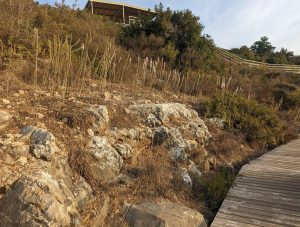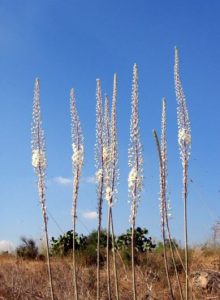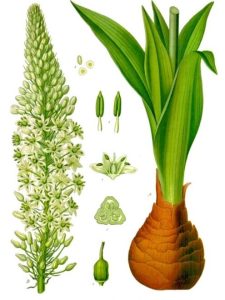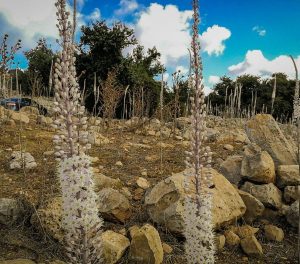Do people still put up white picket fences? Our Gemara discusses a different kind of boundary marker – albeit also white but not exactly a picket fence:
“Rav Asi says that Rabbi Yoḥanan says: The boundary between fields and the חצב (hatzav) serve as a barrier with regard to the property of a convert” (Bava Batra 55a)
The hatzav may also serve to separate two fields for other purposes, such as when one field is impure and the other is not. A page later our Gemara asks what is this hatzav but rather than define the term, it just adds that this was the plant that Joshua used to divide up the land. Rashbam comes to our rescue and explains that the hatzav is a plant that grows straight down and does not take nourishment from the sides of the field. The English name for this plant is the drimia maritima or the sea squill.

חזי חדשי, CC BY-SA 4.0 <https://creativecommons.org/licenses/by-sa/4.0>, via Wikimedia Commons
In a fascinating conversation in Masechet Betzah, the rabbis talk about what lessons we can learn from plants. This is in keeping with their way of looking at the natural world as a reflection of the Torah and its truths. Here we have the hatzav/hatzubah again:
“Rami bar Abba also said: The hatzuba will cut off the feet of the wicked” (Betzah 25b)
Rashi explains that this plant grows straight down and does not “steal” from other fields; in other words it does not take its neighbor’s property. In the next world, when people are judged for trespassing, the hatzuba will stand as a witness – look how I stayed in my own space and did not take anything that did not belong to me! Why didn’t you do the same?
The qualities that make the hatzav a good boundary marker are also those that make it “righteous”: its ability to grow straight down and not go off to the sides. What is this plant and what do we know about it?
Any child who has gone to preschool in Israel can tell you about the hatzav. It is considered one of the harbingers of fall, that season that we long for after the long hot summer. In Hebrew we say:החצב פורח, הקיץ בורח: if the hatzav is flowering, summer is ending (OK, it sounds better in Hebrew). The tall white flowers of the hatzav are a sign that cooler, wetter days are coming.

שומבלע, CC BY-SA 2.5 <https://creativecommons.org/licenses/by-sa/2.5>, via Wikimedia Commons
The hatzav’s name is a clue to its nature. The verb חצב means to dig or to quarry. The roots of the plant indeed grow straight down and dig deep into the earth, three to four meters down. This is the secret to how it can flower at the very end of the summer, when (almost) all the water is gone from the earth. The hatzav reaches deep into the reserves that are still present underground and gets just enough water to flower.
Deep roots and straight lines make the hatzav a great boundary marker. It is extremely hard to uproot and even if you did dig one out, it is easy to reconstruct the border line since the roots go so deep. The hatzav grows from a bulb that might be very tempting for animals to dig up and eat. But here is another hatzav secret – the bulb is highly poisonous and so animals leave it alone.

Franz Eugen Köhler, Köhler’s Medizinal-Pflanzen, Public domain, via Wikimedia Commons
Hatzav plants were used for centuries after the time of the Gemara to mark borders. The Bedouin planted them to mark off their own fields and Arabs sometimes use them to demarcate graves.
One animal does find the hatzav tempting: the gazelle. The Gemara in Shabbat points out what foods you can prepare for animals to eat on Shabbat:
“One may move hatzav on Shabbat because it is food for gazelles and mustard because it is food for doves.” (Shabbat 128a)
A passage in Bereshit Rabba (31:14) lists the many types of food that Noah brought on the ark and says that he brought hatzav for the gazelles (also glass for the ostriches but that is a different story). Do gazelles indeed eat hatzav? A study in northern Israel saw that gazelles change their diet according to what is available at different seasons. In the fall and in the late winter they will eat the hatzav, something that sheep and goats won’t touch. The poison does not affect them because they eat the young leaves that grow in the fall or the wilted ones in late winter; in both cases there is not a lot of poison.
One of the beautiful things about returning to the land of our sources is seeing the landscape that our ancestors saw. The hatzav served a practical purpose but also taught a moral lesson about taking only what belongs to you. Shai Lavi adds another dimension to the hatzav’s qualities. He points out that the hatzav digs deep to find water and to flower after the other plants have given up. It has waited patiently all summer and only in the fall does it blossom. It flowers in a simple white, it isn’t flashy or colorful. It has deep roots, independence and simplicity, a profile that can be an exemplar for our behavior as well.

Laliv g, CC BY-SA 4.0 <https://creativecommons.org/licenses/by-sa/4.0>, via Wikimedia Commons
We just celebrated Tu B’Av. Among other things, this date marks the beginning of shorter, cooler days (Taanit 31a). As the weather becomes less extreme, the hatzav begins to flower, promising us rain and renewal in the months to come.










